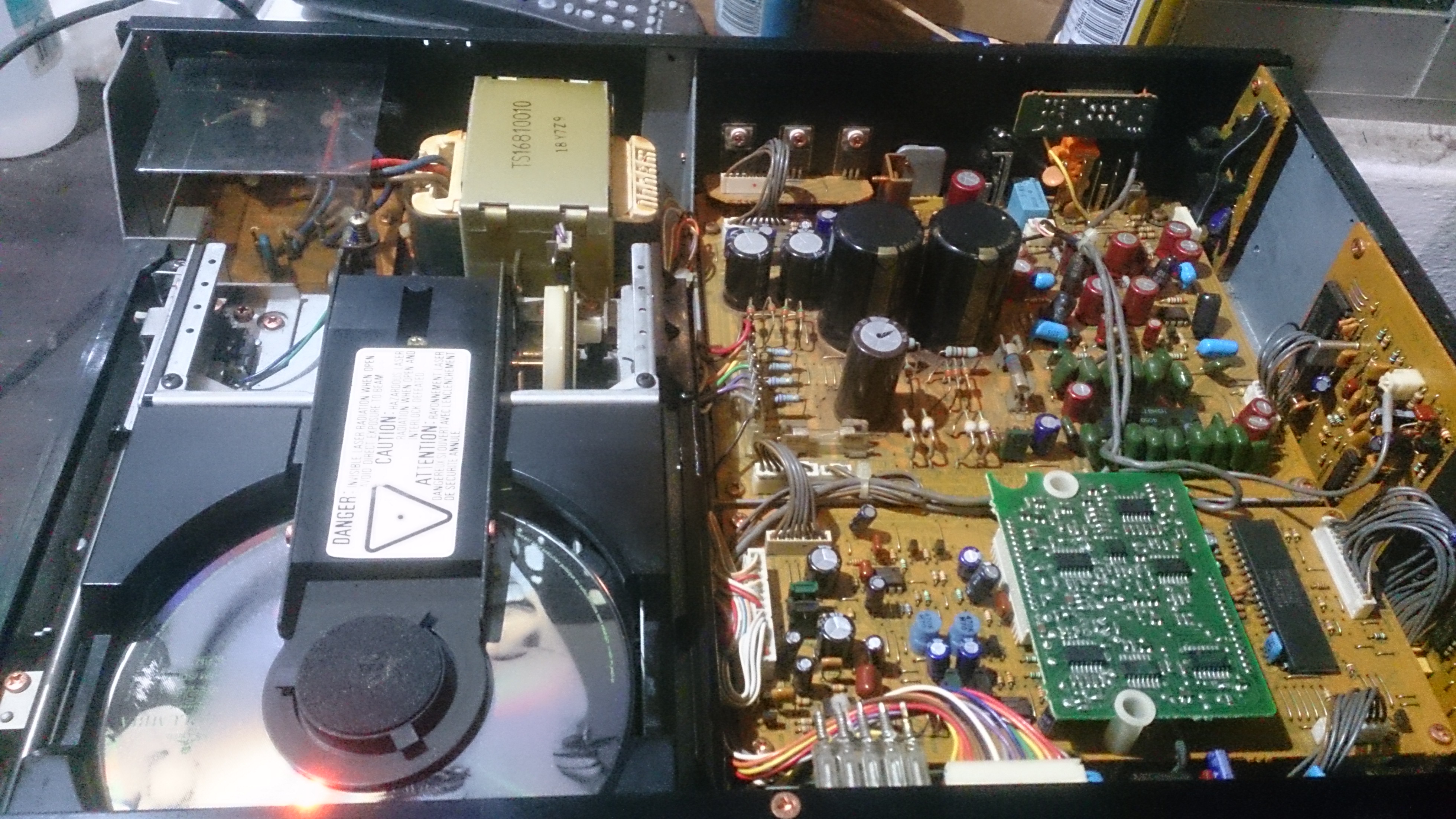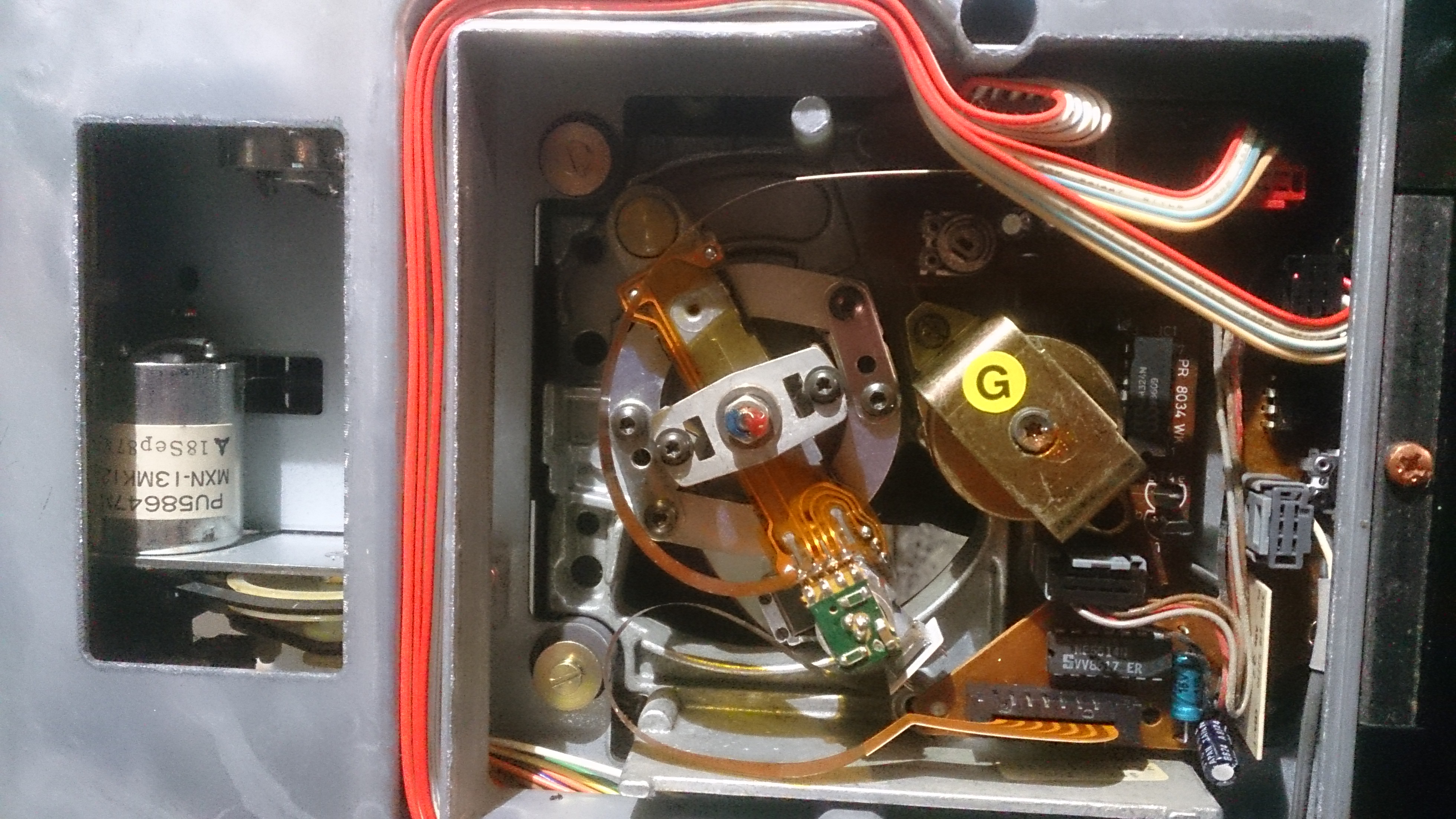Este magnífico leitor super pesado (10 kg) chegou às minhas mãos a pedido de um cliente habitual para o reparar, pois tinha problemas com a gaveta e não reconhecia os CDs. Ele usa a fantástica drive CDM1 e o reconhecido DAC TDA1541. Aqui está uma foto do seu interior:

Fiz alguns testes e ouvia-se a tentativa de ler os CDs e uma vez leu mesmo qualquer coisa. Deu para confirmar então que laser parecia bom (pontinho vermelho visível) e focus coils a mover-se normalmente. Pensei portanto num problema eletrónico (talvez os famosos condensadores) ou mecânico (rolamento do motor desgastado alterando distância entre disco e lente, deixando de focar). Experimentei as service positions - não passa da "0": Swing arm mexe, mas só corretamente para fora, para dentro vai mas volta a descair para o meio. Suspeitei então de um problema na servo board ou no próprio RAFOC (unidade swing arm e laser).
Procedi então com estes testes:
no service loop 0, medi tensão nas ligações radial control (pino 3 e 4 da ficha 12 da placa préamp do CDM1) enquanto carregava em "search forward" ou "search backward" (o que devia mover swing arm para dentro ou fora). No sentido funcional, medi -0,9 V contra massa. No sentido em que fica "parado", não havia tensão, 0 V, provando que efetivamente não havia tensão para o mover para o interior para poder ler o TOC. Fiz a contra-verificação para certificar que o problema não seria do RAFOC: desliguei ficha e apliquei 1,5 V de uma pilha nos pinos 3 e 4. Conforme a polaridade, braço movia-se perfeitamente para o respetivo extremo, provando que a drive estava óptima. Tinha de ser portanto um problema eletrónica na servo board.
Testei sinais radial error da placa préamp: 0 V em todos os pontos do NE5514 comforme indicado no esquema, portanto tudo ok. Injectei sinal de onda sinusoidal 3 Vpp com 10 Hz entre ponto de teste 30 e 31 como mandado no service manual para testar estágio saída radial - funciona, swing arm agora vai livremente para os dois extremos na service position 0, medindo 0,85 V num e -0,85 V no outro, tal como suposto! Como?? O que se passou?? Experimentei ligar o leitor logo a seguir com um disco e não é que reconheceu o disco e tocou lindamente durante um bocado, até mesmo mudar de faixa funcionava?! Desliguei e voltei a ligar passado um bocado e voltou a deixar de funcionar, ao ligar, swing arm já não ia à posição para ler o TOC. Então injectei outra vez o sinal nos pontos 30 e 31 (mesmo com leitor desligado!) e ao ligar logo a seguir, voltou a funcionar! O que pode ser? Algum condensador a ser carregado? Só funcionou algumas vezes. Troquei C233, o único no circuito relacionado, mas não resolveu. Agora estava a falhar praticamente sempre. Verifiquei tensões alimentação - tudo normal. Continuei a busca, tendo pesquisado na Internet também por suspeitos comuns, falam em diodos e os famosos condensadores de filme prateados a ficarem abertos. Mas não encontrei nada disso. Por outro lado, depois descobri o problema ao passar os pontos de solda a pente fino: havia pontos de solda frios no transistor Q232 do circuito servo, ressoldei e ficou a funcionar lindamente. Faz todo o sentido, pois está ligado ao opamp cujas entradas são os pontos 30 e 31, ou seja, ao estimular aquilo com uma corrente externa alternada, mesmo só 3 V, melhorava de alguma forma estranha temporariamente a condutividade desses pontos de solda.
Verifiquei tensão laser: 585 mV, perfeito.
Gaveta não abria sozinha - descobri que tinha massa lubrificante no cabo de aço e massa em excesso nas guias, além disso troquei correias e ficou boa.
Depois notei que havia outro problema: por vezes o CD não arrancava, motor parecia ter dificuldades. Lembrei-me da manutenção descrita aqui que deve ser feita ao CDM1 a cada vinte ou trinta anos, tendo a ver com desgaste do rolamente de nylon. Abri e verifiquei que estava gasto, limei o assento como descrito e ainda alisei o veio com lixa de água ultra fina cuidadosamente. A seguir é necessário ajustar o focus, isso é feito assim: ajustamos a distância com o parafuso até que o íman deixe de tocar na campânula, depois é medir o sinal Focus (-) contra massa com osciloscópio, preferencialmente no início de um CD-R, e ajustar o parafuso até estar perto dos 0 V. Fazer o mesmo com outros CDs e tentar encontrar meio termo. Correu bem e ficou a funcionar muito bem, problemas resolvidos! :)

===============
English:
This fantastic CD player (a heavy one with about 10 kg !) arrived on my work bench because one of my long time clients decided to aks me to repair it - the drawer wasn't working properly and it wouldn't recognize the discs. This player is based around the uniquely well built CDM1 drive from Philips and the acclaimed DAC TDA1541. Please have a look at its gorgeous interior in the photo above (portuguese text).
So, I proceeded with some testing and eventually I would hear the attempt to read the CD and one single time I really got it to play something. This was the confirmation I needed to be sure that the laser was ok (I could also observe the red dot by aiming my mobile phone camera at it) and the focus coils would move normally. I thought it should be some electronic issue (maybe some capacitor?) or mechanic (possibly the bearing of the motor being seized changing focus distance between disc and lens). I tried all the service positions - it wouldn't go beyond the "0": swing arm would move, but only outwards. When trying to move inwards, it would try, but then fall back to middle position. I therefore started to suspect it would be some problem on servo board or on the RAFOC itself (swing arm and laser).
I then proceeded with these tests: in service loop 0, I measured voltage on radial control connections (pin 3 and 4 of connector 12 on the preamp-PCB of CDM1 module) while I was pressing the buttons "search forward" and "search backward" (which should make the swing arm move outside or inside). The working direction gave the result of -0,9 V against GND. In the direction where it would stay "stuck", I couldn't measure any voltage, 0 V - this was the proof that there was no power to move the swing arm inwards in order to read TOC. I did the counter proof to be sure the problem wasn't at the RAFOC: I disconnected the connector and applied 1,5 V from a normaly AA battery cell between pins 3 and 4. According to polarity, the swing arm was moving perfectly until the respective end position, confirming that the drive mechanism itself was fine. It had to be a problem with the electronics on the PCB. I tested the radial error signals from the preamp PCB: 0 V at all pins of NE5514 as expected (from values on schematic), so all was fine. I injected a sinus signal of 3 Vpp and 10 Hz between test point 30 and 31 as described in service manual to test output stage for radial control - it was working, swing arm would now freely move to both end positions in service position 0 and I measured 0,85 V and -0,85 V at either of them, just like it should be! How??! What was going on here?? I tried and turned the player on with a disc inserted and it recognized the disc and played it just fine during a while, even track changes would work!? I switched it off and some time later it stopped working again, swing arm would not go to position to read TOC. So I injected again the signal at test points 30 and 31 (even with player switched off!) and when switching on right after, it would work again! This was weird! What could it be? Some capacitor? It only worked a few times. Maybe some capacitor being charged? I installed a new capacitor at C233, the only one related. No change. Now it was mal functioning almost always. I measured supply voltages - all normal. I continued my investigations and also searched on the Internet for any known issues - found people talking about diodes and those famous silver coloured film caps going open. But nothing of this was going on here. On the other hand, I finally found the problem when I decided to go through solder joints one by one: there were some cold solder joints at transistor Q232, I resoldered and yes! It started working just fine! This made a lot of sense, as the transistor is connected to the opamp with its inputs being testpoints 30 and 31 - this meant that when I was "stimulating" this with some external alternated current, even only as low as 3 V, it would improve in a strange and very short lived way the conductivity of these solder joints.
Then I verified laser voltage: 585 mV, perfect.
The drawer wouldn't open alone - I solved the problem when I noticed that it had an excess of lubrificant on the guides and the steel cable (more isn't always good...) and I also installed a new belt and all started to work just fine.
Then I noticed an additional problem: sometimes the disc wouldn't start to play, the motor seemed to struggle. I remembered the maintenance described here that has to be done with a CDM1 drive every twenty or thirty years - it's related to the nylon bearing wearing out. I opened it and it was really showing significant wear. So I gave it a good treatment like described and in the end polished with very fine sand paper carefully. Afterwards it is necessary to adjust the focus, which is done like this: we adjust the distance between the screw until the magnet stops touching on the bell, then we have to measure the Focus (-) signal against GND with an oscilloscope, ideally with a CD-R playing the first tracks and adjust screw until measuring close to 0 V. Then do the same with other CDs and try to find a position that works ok for all discs. This went well and it started to play CDs just fine. Problems solved :)